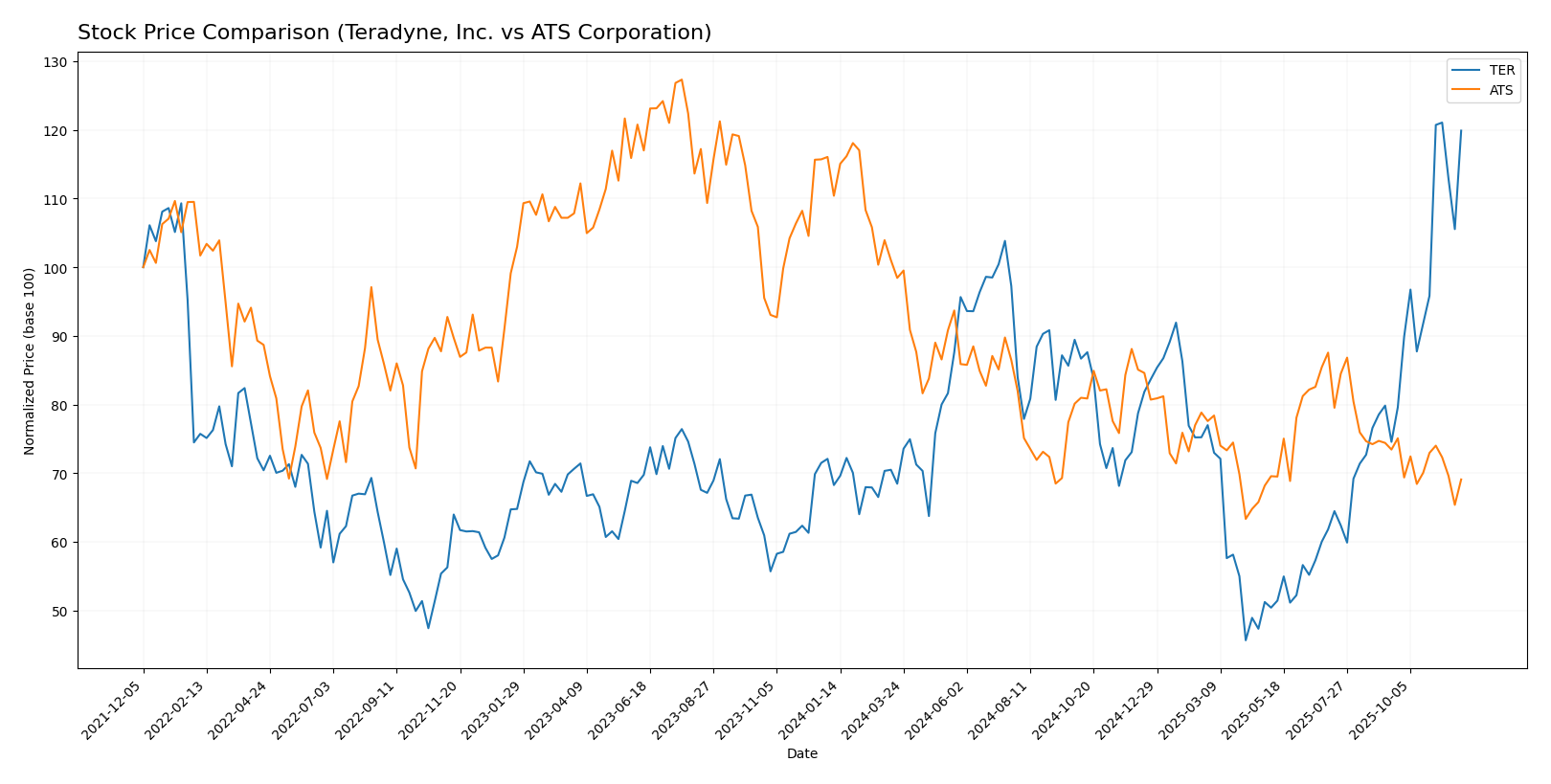In today’s rapidly evolving technological landscape, companies that drive innovation in automation and testing solutions are more crucial than ever. This article compares Teradyne, Inc. (TER) and ATS Corporation (ATS), both of which operate in overlapping sectors of semiconductors and industrial machinery. With a focus on their distinct innovation strategies and market approaches, I aim to uncover which company stands out as the more compelling investment opportunity. Let’s explore these two industry players to determine where your investment might find the most potential.

Table of contents
Company Overview
Teradyne, Inc. Overview
Teradyne, Inc. is a leading provider of automatic test equipment, catering to various sectors, including semiconductors, industrial automation, and wireless devices. Established in 1960 and headquartered in North Reading, Massachusetts, Teradyne operates through several segments: Semiconductor Test, System Test, Industrial Automation, and Wireless Test. The company’s mission is to enhance the efficiency and reliability of electronic devices through innovative testing solutions. With a market cap of approximately $28.9B and a workforce of around 6,500 employees, Teradyne remains a pivotal player in the semiconductor testing landscape, offering sophisticated platforms for diverse applications, from automotive to consumer electronics.
ATS Corporation Overview
ATS Corporation, based in Cambridge, Canada, specializes in automation solutions across various industries, including life sciences, transportation, and consumer products. Founded in 1978, ATS provides comprehensive services that cover the entire automation lifecycle, from planning and design to implementation and maintenance. The company’s mission is to drive operational efficiency and sustainable production improvements through advanced automation technologies. With a market capitalization of about $2.5B and around 7,500 employees, ATS is recognized for its innovative automation products and solutions tailored to meet the evolving demands of manufacturing and assembly processes.
Key similarities between Teradyne and ATS include their focus on technology and innovation, catering to the automation and testing sectors. However, they differ in their primary business models, with Teradyne emphasizing semiconductor testing and ATS providing broader automation solutions across multiple industries.
Income Statement Comparison
The following table presents a comparative analysis of the most recent income statements for Teradyne, Inc. (TER) and ATS Corporation (ATS), highlighting key financial metrics for both companies.
| Metric | Teradyne, Inc. | ATS Corporation |
|---|---|---|
| Revenue | 2.82B | 2.53B |
| EBITDA | 732M | 168M |
| EBIT | 613M | 15M |
| Net Income | 542M | -28M |
| EPS | 3.41 | -0.29 |
Interpretation of Income Statement
In the most recent fiscal year, Teradyne, Inc. experienced a notable revenue increase from 2.68B to 2.82B, reflecting a solid demand in its sector, while its net income rose to 542M, showcasing improved profitability. Conversely, ATS Corporation faced a revenue decline from 3.03B to 2.53B, leading to a net loss of 28M. The margins indicate that Teradyne maintained strong profitability, whereas ATS’s margins were under pressure, highlighting a need for strategic reassessment. Overall, Teradyne’s financials reflect resilience, while ATS’s performance signals potential challenges ahead.
Financial Ratios Comparison
The following table presents a comparative overview of key financial ratios for Teradyne, Inc. (TER) and ATS Corporation (ATS) based on the most recent fiscal data available.
| Metric | [Company A] (TER) | [Company B] (ATS) |
|---|---|---|
| ROE | 19.24% | -1.64% |
| ROIC | 17.25% | 0.09% |
| P/E | 36.93 | -125.28 |
| P/B | 7.11 | 2.06 |
| Current Ratio | 2.91 | 1.69 |
| Quick Ratio | 1.84 | 1.41 |
| D/E | 0.03 | 1.00 |
| Debt-to-Assets | 0.02 | 0.37 |
| Interest Coverage | 165.54 | 0.09 |
| Asset Turnover | 0.76 | 0.55 |
| Fixed Asset Turnover | 4.88 | 5.66 |
| Payout ratio | 14.09% | 0.00% |
| Dividend yield | 0.38% | 0.00% |
Interpretation of Financial Ratios
Analyzing the ratios, Teradyne exhibits strong performance across most metrics, particularly in ROE, ROIC, and interest coverage, indicating solid profitability and effective capital management. Conversely, ATS’s negative P/E and low ROE suggest financial struggles, with high leverage and weak profitability. Investors should approach ATS with caution, while Teradyne appears to be a more stable investment option.
Dividend and Shareholder Returns
Teradyne, Inc. (TER) has a dividend payout ratio of approximately 14.1% with a dividend yield of 0.38%, indicating a commitment to returning value to shareholders while maintaining sufficient cash flow for growth. In contrast, ATS Corporation (ATS) does not pay dividends, likely due to its negative net income and focus on reinvestment for growth. Both companies engage in share buybacks, but TER’s dividend strategy appears more sustainable for long-term shareholder value creation compared to ATS’s aggressive growth approach.
Strategic Positioning
Teradyne, Inc. holds a significant market share in the semiconductor testing sector, driven by its advanced testing solutions across multiple segments. Its competitive pressure is marked by technological advancements and innovations from peers like ATS Corporation, which specializes in automation solutions. While Teradyne’s robust portfolio positions it well, ATS faces challenges from rapid technological disruptions in the industrial automation space, necessitating continuous adaptation to maintain market relevance.
Stock Comparison
In evaluating the stock performance of Teradyne, Inc. (TER) and ATS Corporation (ATS) over the past year, we observe significant disparities in price movements and trading dynamics that warrant close examination.

Trend Analysis
Teradyne, Inc. (TER) has demonstrated a remarkable bullish trend, with a price change of 75.64% over the past year. The stock has experienced notable acceleration, reaching a highest price of 182.28 and a lowest price of 68.72. The standard deviation of 24.49 indicates some volatility, but it is primarily characterized by upward momentum.
In the recent period from September 14, 2025, to November 30, 2025, TER has achieved a price change of 60.83%, with a trend slope of 5.89, further reinforcing its bullish trajectory.
ATS Corporation (ATS), on the other hand, has exhibited a bearish trend with a price change of -37.43% over the same timeframe. The trend is characterized by deceleration, with a highest price of 43.82 and a lowest price of 23.50. The standard deviation of 4.44 suggests lower volatility compared to TER.
In the recent period from September 14, 2025, to November 30, 2025, ATS has seen a slight decline of -5.93%, accompanied by a trend slope of -0.15, which indicates a continued bearish sentiment.
Analyst Opinions
Recent analyst recommendations indicate a cautious stance towards Teradyne, Inc. (TER), with a rating of “B” based on strong return metrics, particularly in return on assets (5) and equity (4). Analysts suggest it is a buy due to its robust financial health. Conversely, ATS Corporation (ATS) has received a “C” rating, reflecting concerns over weaker performance indicators, particularly in return on equity and assets, suggesting a hold strategy. Overall, the consensus for Teradyne is a buy, while ATS leans towards a hold.
Stock Grades
In this section, I will present the most recent stock ratings for Teradyne, Inc. and ATS Corporation, based on reliable data from recognized grading companies.
Teradyne, Inc. Grades
| Grading Company | Action | New Grade | Date |
|---|---|---|---|
| Citigroup | Maintain | Buy | 2025-11-12 |
| Goldman Sachs | Maintain | Sell | 2025-10-30 |
| JP Morgan | Maintain | Neutral | 2025-10-30 |
| UBS | Maintain | Buy | 2025-10-30 |
| Evercore ISI Group | Maintain | Outperform | 2025-10-30 |
| Stifel | Maintain | Hold | 2025-10-28 |
| Evercore ISI Group | Maintain | Outperform | 2025-10-28 |
| UBS | Maintain | Buy | 2025-10-20 |
| Morgan Stanley | Maintain | Equal Weight | 2025-10-14 |
| Stifel | Maintain | Hold | 2025-10-13 |
ATS Corporation Grades
| Grading Company | Action | New Grade | Date |
|---|---|---|---|
| JP Morgan | Maintain | Neutral | 2024-08-13 |
| Goldman Sachs | Maintain | Sell | 2024-08-13 |
| JP Morgan | Maintain | Neutral | 2024-05-24 |
Overall, Teradyne, Inc. displays a mixed bag of grades from various firms, with a notable number of “Buy” ratings, indicating a generally positive outlook among analysts despite some contrasting views. ATS Corporation, on the other hand, shows a more cautious stance, particularly with consistent “Sell” and “Neutral” ratings, suggesting a need for careful evaluation before investment.
Target Prices
The latest target price data reveals insights from analysts on two companies.
| Company | Target High | Target Low | Consensus |
|---|---|---|---|
| Teradyne, Inc. | 215 | 119 | 172.67 |
| ATS Corporation | 34 | 34 | 34 |
Analysts have a bullish consensus for Teradyne, with a target price of 172.67, suggesting potential upside from the current price of 179.68. In contrast, ATS’s consensus target matches its current price of 25.595, indicating limited expected movement.
Strengths and Weaknesses
The following table outlines the strengths and weaknesses of Teradyne, Inc. (TER) and ATS Corporation (ATS) based on the latest data.
| Criterion | Teradyne, Inc. (TER) | ATS Corporation (ATS) |
|---|---|---|
| Diversification | High | Moderate |
| Profitability | Strong (net margin: 19.2%) | Weak (net margin: -1.1%) |
| Innovation | High | Moderate |
| Global presence | Strong | Moderate |
| Market Share | Leading in Semiconductors | Niche market |
| Debt level | Low (debt-to-equity: 0.03) | High (debt-to-equity: 0.99) |
In summary, Teradyne displays strong profitability and a robust market position with low debt levels, making it an attractive choice for investors. In contrast, ATS faces profitability challenges and higher debt, which may pose risks for potential investors.
Risk Analysis
The following table outlines key risks associated with two companies: Teradyne, Inc. and ATS Corporation.
| Metric | Teradyne, Inc. | ATS Corporation |
|---|---|---|
| Market Risk | High | Moderate |
| Regulatory Risk | Moderate | High |
| Operational Risk | Low | High |
| Environmental Risk | Low | Moderate |
| Geopolitical Risk | Moderate | High |
In my analysis, the most significant risks for Teradyne involve market fluctuations and regulatory changes, particularly given its exposure to semiconductor demand. ATS faces considerable operational and regulatory challenges, which could impact its profitability and growth trajectory.
Which one to choose?
When comparing Teradyne, Inc. (TER) and ATS Corporation (ATS), Teradyne shows stronger fundamentals, boasting a net profit margin of 19.23% and a return on equity of 19.24%. Its current ratio of 2.91 indicates good liquidity, while its stock trend remains bullish, reflecting a price change of +75.64% over the last year. In contrast, ATS’s recent performance suggests a bearish trend, with a price decline of -37.43% and a net loss reported for 2025. ATS’s lower overall rating of C compared to Teradyne’s B further highlights the disparity.
Investors focused on growth may prefer Teradyne, while those prioritizing stability might find ATS an option, though caution is advised due to its current financial struggles. The primary risk for both companies stems from market dependence and competitive pressures.
Disclaimer: This article is not financial advice. Each investor is responsible for their own investment decisions.
Go further
I encourage you to read the complete analyses of Teradyne, Inc. and ATS Corporation to enhance your investment decisions:



